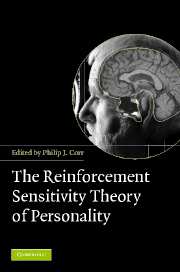Book contents
- Frontmatter
- Contents
- List of abbreviations
- List of figures
- List of tables
- List of contributors
- Preface
- 1 Reinforcement Sensitivity Theory (RST): introduction
- 2 The neuropsychology of fear and anxiety: a foundation for Reinforcement Sensitivity Theory
- 3 Animal cognition and human personality
- 4 The behavioural activation system: challenges and opportunities
- 5 Reinforcement Sensitivity Theory and personality
- 6 Reinforcement sensitivity scales
- 7 Performance and conditioning studies
- 8 Psychophysiological studies
- 9 Reinforcement Sensitivity Theory and mood induction studies
- 10 Neuro-imaging and genetics
- 11 Reinforcement Sensitivity Theory and psychosomatic medicine
- 12 RST and clinical disorders: anxiety and depression
- 13 RST and psychopathy: associations between psychopathy and the behavioral activation and inhibition systems
- 14 Behavioural activation and inhibition in social adjustment
- 15 Reinforcement sensitivity in the workplace: BIS/BAS in business
- 16 Formal and computational models of Reinforcement Sensitivity Theory
- 17 Reinforcement Sensitivity Theory: a critique from cognitive science
- 18 The contribution of Reinforcement Sensitivity Theory to personality theory
- General Index
- Index of Names
- References
15 - Reinforcement sensitivity in the workplace: BIS/BAS in business
Published online by Cambridge University Press: 31 January 2011
- Frontmatter
- Contents
- List of abbreviations
- List of figures
- List of tables
- List of contributors
- Preface
- 1 Reinforcement Sensitivity Theory (RST): introduction
- 2 The neuropsychology of fear and anxiety: a foundation for Reinforcement Sensitivity Theory
- 3 Animal cognition and human personality
- 4 The behavioural activation system: challenges and opportunities
- 5 Reinforcement Sensitivity Theory and personality
- 6 Reinforcement sensitivity scales
- 7 Performance and conditioning studies
- 8 Psychophysiological studies
- 9 Reinforcement Sensitivity Theory and mood induction studies
- 10 Neuro-imaging and genetics
- 11 Reinforcement Sensitivity Theory and psychosomatic medicine
- 12 RST and clinical disorders: anxiety and depression
- 13 RST and psychopathy: associations between psychopathy and the behavioral activation and inhibition systems
- 14 Behavioural activation and inhibition in social adjustment
- 15 Reinforcement sensitivity in the workplace: BIS/BAS in business
- 16 Formal and computational models of Reinforcement Sensitivity Theory
- 17 Reinforcement Sensitivity Theory: a critique from cognitive science
- 18 The contribution of Reinforcement Sensitivity Theory to personality theory
- General Index
- Index of Names
- References
Summary
Personality theorists usually get ever more adventurous as they set out empirically to test their ever more sophisticated theories. Most naturally begin in the laboratory, sometimes even the animal house, testing fundamental (biological and behavioural) tenets of the theory, which develops and changes as it is tested. However, demands both for ecological validity and applicability mean they soon find themselves testing theoretical assumptions on ‘real people in real settings’. These settings are most frequently the clinic, the classroom and the office/factory.
Any inspection of work of the trait theorists like Eysenck, Cattell and latterly Costa and McCrae shows how they usually first became interested in the clinical applications of their work, then the educational applications and finally the occupational and organizational applications. Perhaps because Eysenck was at the Institute of Psychiatry (though neither a trained nor practising clinician) he took a great deal of interest in clinical issues with all three dimensions (i.e., Extraversion, Neuroticism and Psychoticism) having obvious clinical implications. Being both a trained clinician and a student of Eysenck, it is no surprise that Jeffrey Gray too, chose to test many of his ideas first on rats and then on patients.
Raymond Cattell, of the three, seemed more interested in the educational sphere, both because of his educational training but also because of his work on intelligence. Similarly Hans Eysenck was always interested in learning theory and intelligence and always took an active interest in how both personality and intelligence predicted educational behaviours and outcomes.
- Type
- Chapter
- Information
- The Reinforcement Sensitivity Theory of Personality , pp. 431 - 452Publisher: Cambridge University PressPrint publication year: 2008
References
- 6
- Cited by



